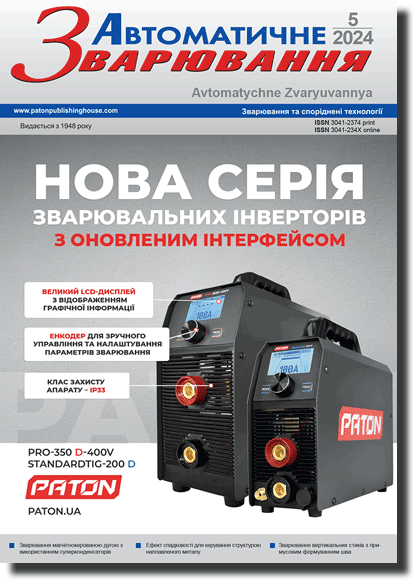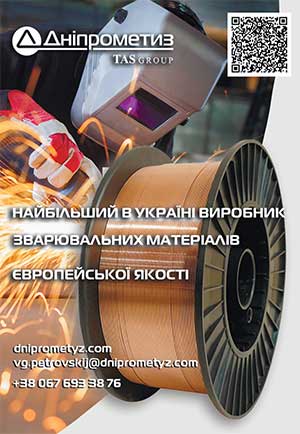| 2024 №05 (02) |
DOI of Article 10.37434/as2024.05.03 |
2024 №05 (04) |

"Avtomatychne Zvaryuvannya" (Automatic Welding), #5, 2024, pp. 25-31
Dispersed carbide effect on the kinetics of weld metal structural transformations
V.V. Holovko, V.A. Kostin, V.V. Zhukov
E.O. Paton Electric Welding Institute of the NASU. 11 Kazymyr Malevych Str., 03150, Kyiv, Ukraine. E-mail: v_golovko@ukr.netThe results of research on the influence of inoculation of refractory titanium and silicon carbide particles into the weld pool are presented. It is shown that inoculation of the weld metal with silicon carbides leads to an increase in the temperatures of the bainitic transformation beginning and end and a decrease in its temperature range in comparison with the basic version. Strength values decrease, and ductility and toughness increase in relation to the basic version. Inoculation of the weld pool with refractory TiC particles influences the structural transformation temperature of the hardening metal and its mechanical properties. Both the beginning and end temperature of the bainite transformation increases, that is bainite formation occurs in the higher temperature region, and the temperature range of this region narrows (the transformation kinetics increases). 13 Ref., 3 Tabl., 4 Fig.
Keywords: welding, microstructure, dispersed carbides, weld pool inoculation, bainitic transformation
Received: 26.06.2024
Received in revised form: 06.08.2024
Accepted: 14.10.2024
References
1. Bestuzhev, N.Y., Mikhailovsky,V.M. Bestuzhev, A.N. et al. (2003) Complex inoculating processing of liquid cast iron. Liteinoe Proizvodstvo, 10, 6-8 [in Rissian].2. Kopycinski, D. , Dorula, J. (2010) The influence of iron powder and disintegrated steel scrap additives on the solidification of cast iron. Metallurgy and Foundry Engineering, 36(2), 97-102. https://doi.org/10.7494/mafe.2010.36.2.97
3. Boldyrev, D.A., Davydov, S.V., Skantsev, V.M. (2007) The main principles of the economic efficiency of the introduction of new types of modifiers in cast iron production. Zagotovitelnye Proizvodstva v Mashinostroenii, 9, 9-16 [in Russian].
4. Vashukov, I.A. (1978) Structure formation during the formation of castings from unalloyed and alloyed cast irons. Liteinoe Proizvodstvo, 2, 4-5.
5. Zou, Y. Tan, C., Qiu, Z., Ma, W. et al. (2021) Additively manufactured SiC-reinforced stainless steel with excellent strength and wear resistance. Additive Manufacturing, 41, 101971. https://doi.org/10.1016/j.addma.2021.101971
6. Huang, X., Mei, S., Li, Y. et al. (2023) Effect of TiC content on microstructure and wear performance of 17-4PH stainless steel composites manufactured by indirect metal 3D printing. Materials, 16, 6449. https://doi.org/10.3390/ma16196449
7. Liu, G.W., Muolo, M.L., Valenza, F., Passerone A. (2010) Survey on wetting of SiC by molten metals. Ceramic International J., 36, 4, 1177-1188. https://doi.org/10.1016/j.ceramint.2010.01.001
8. Omranian, P., Shakeri, N., Mohamemadpour, A. et al. (2013) Use of silicon carbide as an inoculant in ductile iron casting to reduce the cost with keeping the properties. Metal J., 15(5), 1-5.
9. Kamal El-Fawkhry, M., Shash, A., Sherif, A. et al. (2014) Enhancement of pearlitic structure through inoculation with nano-size silicon carbide. Int. J. Nanoparticles, 7(3/4), 203-211. https://doi.org/10.1504/IJNP.2014.067607
10. (2008) International standard ISO 14171:2008(E) Welding consumables - Wire electrodes and wire-flux combinations for submerged arc welding of non alloy and fine grain steels - Classification.
11. (2003) International standard ISO 17639:2003 Destructive tests on welds in metallic materials - Macroscopic and microscopic examination of welds.
12. (1990) IIW Doc. No.lX-1533-88/IXJ-123-87 Revision 2/ June 1988 Guide to the light microscope examination of ferritic steel weld metals.
13. Kostin, V.A., Golovko, V.V., Grigorenko, G.M. (2011) Methods for assessment of the strengthening of HSLA steel weld metal. The Paton Welding J., 10, 12-17.
Advertising in this issue:
To order the electronic version of the paper:
V.V. Holovko, V.A. Kostin, V.V. ZhukovDispersed carbide effect on the kinetics of weld metal structural transformations
Automatic Welding №05 2024 p.25-31
The cost of article (pdf): 13 $, 12 €, 150 UAH (1 copy. )
fill in the form below:
The cost of subscription/purchase order journals or individual articles
| Journal/Currency | Annual Set | 1 issue printed |
1 issue |
one article |
| TPWJ/USD | 384 $ | 32 $ | 26 $ | 13 $ |
| TPWJ/EUR | 348 € | 29 € | 24 € | 12 € |
| TPWJ/UAH | 7200 UAH | 600 UAH | 600 UAH | 280 UAH |
| AS/UAH | 1800 UAH | 300 UAH | 300 UAH | 150 UAH |
| AS/USD | 192 $ | 32 $ | 26 $ | 13 $ |
| AS/EUR | 180 € | 30 € | 25 € | 12 € |
| SEM/UAH | 1200 UAH | 300 UAH | 300 UAH | 150 UAH |
| SEM/USD | 128 $ | 32 $ | 26 $ | 13 $ |
| SEM/EUR | 120 € | 30 € | 25 € | 12 € |
| TDNK/UAH | 1200 UAH | 300 UAH | 300 UAH | 150 UAH |
| TDNK/USD | 128 $ | 32 $ | 26 $ | 13 $ |
| TDNK/EUR | 120 € | 30 € | 25 € | 15 € |
AS = «Automatic Welding» - 6 issues per year;
TPWJ = «PATON WELDING JOURNAL» - 12 issues per year;
SEM = «Electrometallurgy Today» - 4 issues per year;
TDNK = «Technical Diagnostics and Non-Destructive Testing» - 4 issues per year.









